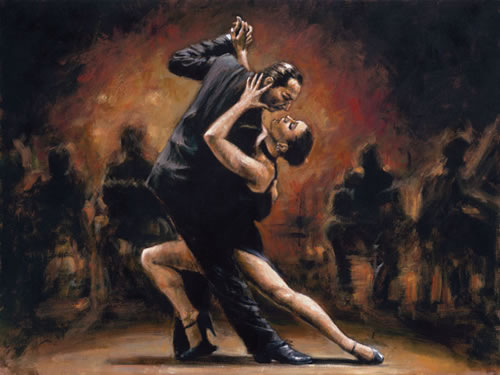
The Tango
If you are looking for an obsession to completely take over and change your life, by all accounts that I’ve read, the Tango is your answer. Of the dozen or so sources I perused, each began with a simple story: the author’s first experience with the Tango, clear concise romantic images, that seem like only yesterday, depicting the moment that changed their life forever. Be it the describing of “an occasional breeze, redolent brackish river water drifting over the docks” or “pressing my chest that contains my broken heart gently, slowly into his,” or “finding the Holy Grail” experiencing the Tango for the first time seems to be an epic moment. There are even stories about famous people, like Robert Duvall, who are addicted to the Tango.
The Tango originates in Buenos Aires, Argentina in the 1930s± in a mysterious swath of legend and tradition. For a man to learn to dance the Tango is to embark on a journey. It begins by learning the part of the follow and only once deemed ready, to then be allowed to practice the part of the lead. Gradual progress is made until one day a more experienced lead invites him to attend a milonga (dance). This is only a step in the journey as dancing with a woman is a privilege and one must continually attend práctica to acquire the skills necessary. Christine Denniston describes learning the Tango:
I have asked many elderly men, from many different parts of the city, how long this process took (baring in mind that the men I speak to for my research are generally the outstanding ones, who would not have been the slowest members of their group), and I have never been told that it took less than nine months to learn to dance the woman’s part well enough to be allowed to start learning to lead. They would then continue to learn, dancing both parts, gradually leading more, until one night one of the more experienced men would tell them to put on a suit on Saturday because they were going to a dance, or milonga. I have asked many elderly men how long that whole process took, and not one has told me that it took less than three years.
In 1955 a regime change in Argentina had dramatic consequences for all of Argentina, and for the Tango in particular. Being associated with the former leader, General Perón, many of the Tango artists were either imprisoned or blacklisted. In a subversive attempt by the new regime to annihilate the Tango, minors were forbidden to attend nightclubs, but the law was only enforced at clubs that danced the Tango. A dramatic generational line was instantly created, distinguishing the generation of men 18 years and older who spent years learning the Tango, with the minors who never learned it at all. Interest in the Tango eventually dwindled and it was lost to obscurity.
In the early 1980s havoc ransacked the political landscape in Argentina and in 1983 the dramatic change in leadership filled Argentineans with new life. As Christine Denniston recounts:
Friends of mine who were in Buenos Aires at that time tell me the atmosphere was extraordinary. Suddenly everyone wanted to move. It was as though a physical weight had been lifted from them. Yoga classes were full. Martial arts classes were full. Dance classes of all kinds were full. And suddenly people wanted to learn to dance Tango, the ultimate symbol of Argentina to the rest of the world, because suddenly it felt all right to be proud to be Argentine again.
This brings us to the Tango as it is known today. Awe-inspiring, breathless, alluring. The younger generation, inspired by not well versed in the ways of the Tango merged with those of the lost Tango generation and the passion persists. It’s not dance steps that you learn, it’s a way to live and breath, a way to experience the world.
ATOMIC Ballroom hosts many Tango classes each week. Click here for a complete listing of Tango Classes at ATOMIC.
